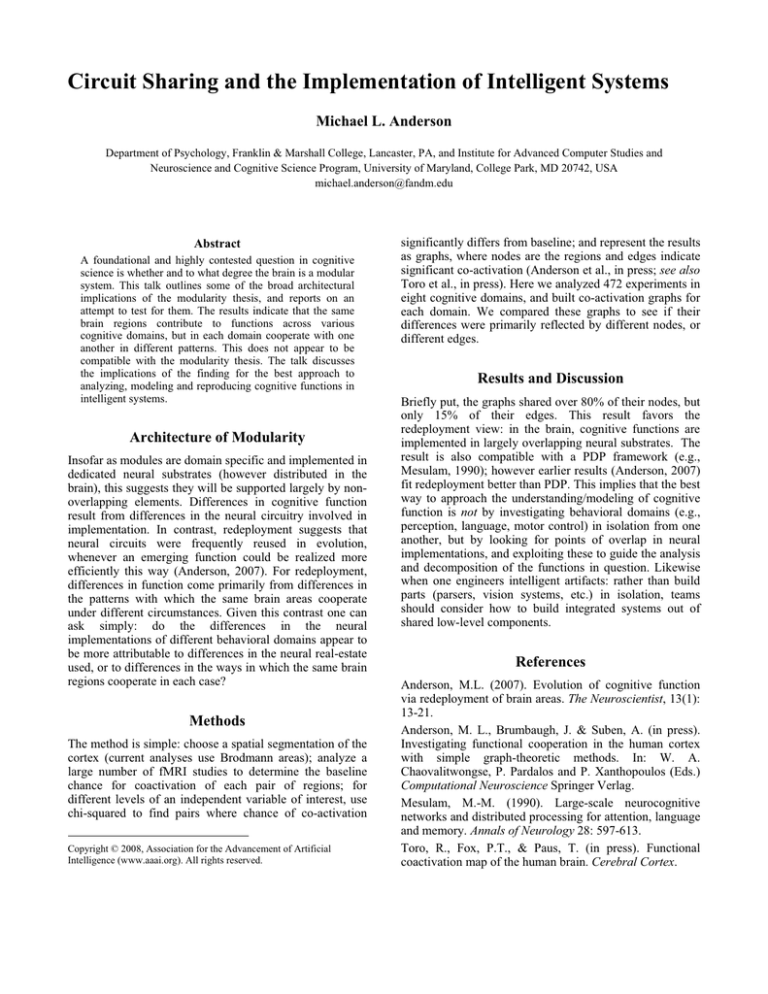
Circuit Sharing and the Implementation of Intelligent Systems
Michael L. Anderson
Department of Psychology, Franklin & Marshall College, Lancaster, PA, and Institute for Advanced Computer Studies and
Neuroscience and Cognitive Science Program, University of Maryland, College Park, MD 20742, USA
michael.anderson@fandm.edu
Abstract
A foundational and highly contested question in cognitive
science is whether and to what degree the brain is a modular
system. This talk outlines some of the broad architectural
implications of the modularity thesis, and reports on an
attempt to test for them. The results indicate that the same
brain regions contribute to functions across various
cognitive domains, but in each domain cooperate with one
another in different patterns. This does not appear to be
compatible with the modularity thesis. The talk discusses
the implications of the finding for the best approach to
analyzing, modeling and reproducing cognitive functions in
intelligent systems.
Architecture of Modularity
Insofar as modules are domain specific and implemented in
dedicated neural substrates (however distributed in the
brain), this suggests they will be supported largely by nonoverlapping elements. Differences in cognitive function
result from differences in the neural circuitry involved in
implementation. In contrast, redeployment suggests that
neural circuits were frequently reused in evolution,
whenever an emerging function could be realized more
efficiently this way (Anderson, 2007). For redeployment,
differences in function come primarily from differences in
the patterns with which the same brain areas cooperate
under different circumstances. Given this contrast one can
ask simply: do the differences in the neural
implementations of different behavioral domains appear to
be more attributable to differences in the neural real-estate
used, or to differences in the ways in which the same brain
regions cooperate in each case?
Methods
The method is simple: choose a spatial segmentation of the
cortex (current analyses use Brodmann areas); analyze a
large number of fMRI studies to determine the baseline
chance for coactivation of each pair of regions; for
different levels of an independent variable of interest, use
chi-squared to find pairs where chance of co-activation
Copyright © 2008, Association for the Advancement of Artificial
Intelligence (www.aaai.org). All rights reserved.
significantly differs from baseline; and represent the results
as graphs, where nodes are the regions and edges indicate
significant co-activation (Anderson et al., in press; see also
Toro et al., in press). Here we analyzed 472 experiments in
eight cognitive domains, and built co-activation graphs for
each domain. We compared these graphs to see if their
differences were primarily reflected by different nodes, or
different edges.
Results and Discussion
Briefly put, the graphs shared over 80% of their nodes, but
only 15% of their edges. This result favors the
redeployment view: in the brain, cognitive functions are
implemented in largely overlapping neural substrates. The
result is also compatible with a PDP framework (e.g.,
Mesulam, 1990); however earlier results (Anderson, 2007)
fit redeployment better than PDP. This implies that the best
way to approach the understanding/modeling of cognitive
function is not by investigating behavioral domains (e.g.,
perception, language, motor control) in isolation from one
another, but by looking for points of overlap in neural
implementations, and exploiting these to guide the analysis
and decomposition of the functions in question. Likewise
when one engineers intelligent artifacts: rather than build
parts (parsers, vision systems, etc.) in isolation, teams
should consider how to build integrated systems out of
shared low-level components.
References
Anderson, M.L. (2007). Evolution of cognitive function
via redeployment of brain areas. The Neuroscientist, 13(1):
13-21.
Anderson, M. L., Brumbaugh, J. & Suben, A. (in press).
Investigating functional cooperation in the human cortex
with simple graph-theoretic methods. In: W. A.
Chaovalitwongse, P. Pardalos and P. Xanthopoulos (Eds.)
Computational Neuroscience Springer Verlag.
Mesulam, M.-M. (1990). Large-scale neurocognitive
networks and distributed processing for attention, language
and memory. Annals of Neurology 28: 597-613.
Toro, R., Fox, P.T., & Paus, T. (in press). Functional
coactivation map of the human brain. Cerebral Cortex.



